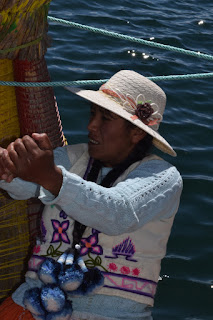We got up very early to leave the hotel
around 6. Alvaro met us at the hotel, and took us to the Inka
Express bus station. There were only 9 people on the bus, two
Poles, two French, two German, and one Taiwanese lady. The bus had
a driver, a tour guide, and a host/hostess.
Our first stop was at a very elaborate
small church in Andahuaylillas. They promote it as the Sistine
Chapel of the Americas, but this is greatly overstated. There are
somewhat primitive murals, including one showing the route to heaven
and the route to hell, as well as drawings of the saints. This was
built during the evangelization period by the Jesuits, and the
drawings were intended to teach the gospel to people who did not
speak Spanish and could not read or write. We were not allowed to
take photos, so I pulled one from the web.
Our second stop was at the somewhat
interesting ruins of Raqchi, very different from what we had seen in
the highlands, generally ruins with stone bases and adobe brick
above.
The landscape changed to pure
altiplano, a wide valley with brown grass, surrounded by mountains,
and sometimes a small village. It felt a lot like parts of
Colorado, such as the San Luis Valley.
The top of the pass was rainy and
blowing hard, 14,300 ft elevation. There were other more forgettable
stops. We were glad to arrive in Puno. Our guide, Jorge, sent a
driver to pick us up, and met us at the hotel. We took a short walk
to La Casona for dinner, and went to bed early. Richard had not
felt well, so the early bedtime was welcome.
We saw groups of people in various
cemeteries along the way, apparently for the day of the dead
celebration, which is a holiday in Peru.
On Saturday morning, Jorge and a driver picked us up, and we took the boat
to the floating islands of Uros. We visited one of the floating
islands, where the president of the ten person island demonstrated
how the islands were made. He invited us into his house, which was
very small, with solar lighting.
We bought an embroidered piece,
ducks in a blue theme, and took a ride on a reed boat to one of the
larger islands. Richard got to row the boat. It was a touristic,
but nice experience.
Then we went on the island of Tequile.
The hike had about a 500 ft gain in elevation, to the main village,
on a good stone trail. We visited the textile cooperative, where
Sandi bought a doubleweave belt. Their textiles had bright colors
and was made of acrylic. We had lunch at a family restaurant, where
they demonstrated a folkloric dance, and also their knitting, which
is very fine and very fast, including a hooked needle to facilitate
working with the fine fibers. The hike back to the boat was very
steep, and we were the last ones on the boat.
Rather than go back to our hotel, we
asked to be dropped off at the local cemetery for the Day of the Dead
celebration, which was quite a spectacle. Many people were leaving
flowers for their loved ones. We had been told that people would
drink, eat, and sing what the deceased loved.
We met Victor and
Angel, and drank some beer with them; they had already had quite a
bit of beer. We also spoke to another family. Sandi was concerned
that we were intruding, but we tried to be respectful, and of course
asked for permission to take photos. I only took a few photos,
trying not be the ugly American tourist. It was an experience. We
took a taxi back to the hotel. As one of the locals said, the celebration in Peru is very similar to the celebration in Mexico.We attended mass in the nearby St. John the Baptist church, where they have the image of the Virgin of Candelaria. In February, they have a huge fiesta in her honor. Puno claims to be the capital of folklore in Peru; we were told that the folks from Puno will have a big party for any possible occasion.











No comments:
Post a Comment